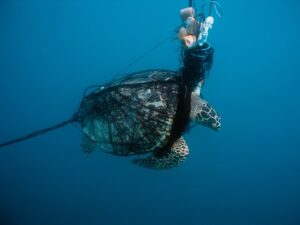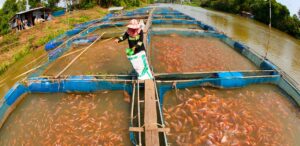-
Adopt
-
Veterinary Care
Services
Client Information
- What to Expect – Angell Boston
- Client Rights and Responsibilities
- Payments / Financial Assistance
- Pharmacy
- Client Policies
- Our Doctors
- Grief Support / Counseling
- Directions and Parking
- Helpful “How-to” Pet Care
Online Payments
Referrals
- Referral Forms/Contact
- Direct Connect
- Referring Veterinarian Portal
- Clinical Articles
- Partners in Care Newsletter
CE, Internships & Alumni Info
CE Seminar Schedule
Emergency: Boston
Emergency: Waltham
Poison Control Hotline
-
Programs & Resources
- Careers
-
Donate Now
Wild-Caught Farm-Raised Welfare Health and Safety Fun Facts
Seafood: A New Form of Factory Farming
The United Nations’ Food and Agriculture Organization (FAO) has estimated that fish and seafood provides more than 3.3 billion people with almost 20% of their intake of animal protein. From 1990 to 2018, the global fish consumption has risen by 122%. Resulting from an increase in demand, there has been an increase in “aquaculture.” Aquaculture is the breeding, rearing, and harvesting of fish, shellfish, algae and other organisms in any type of water. As fisheries and commercial fishing vessels respond to demand, according to the FAO, in 2017, only an estimated 65.8% of fish stocks are within biologically sustainable levels. Sustainable fish stocks are now down 24.2% from 1990. In 2018, global fish production reached nearly 179 million tons, 35% of which was either lost or wasted.
From The Sea
Commercial fishing vessels play a huge role in depleting marine populations and their habitats. Where overfishing persists, it eventually causes fish populations to collapse because the populations cannot breed fast enough to replace the individuals removed by fishing. Species of salmon, trout, and sturgeon are all on the IUCN’s threatened and endangered species list. While species such as cod, tuna, haddock, and halibut are all vulnerable to extinction, largely due to overfishing.
Methods used by large-scale fisheries often prove deadly to many other marine creatures who share their home with commercially-targeted fish species. Most large scale fishing vessels use huge nets, long-lines and/or bottom trawls which often trap or fatally wound non-target species, such as dolphins, whales, sea lions, seals, manatees, and sea turtles. Bait and catch in nets and on lines also prove to be a fatal attraction to seabirds and other scavengers. Nets lost at sea indiscriminately catch and kill marine life. Some fisheries use dynamite or cyanide to bring fish to the surface, which greatly damages ecosystems such as coral reefs.
From The Farm
Fish can be either collected from the wild, as discussed above, or farmed in much the same way as cattle or chickens. Currently, over 80 percent of the seafood Americans consume is imported and more than half is farm raised.
Fish farms raise fish commercially in tanks or enclosures, usually for food. Fish species raised in fish farms include, among others, salmon, catfish, tilapia, cod, carp, and trout. Fish densities are often very high in these commercial enclosures; this increases the risk of infections by parasites, intestinal worms and bacteria because pathogens can easily invade fish bodies through the gills. Water pollution and oxygen depletion in these commercial enclosures can also swiftly destroy a fish population. Read The Humane Society’s report on the welfare of animals in the aquaculture industry.
Octopus
Octopuses have become increasingly desired as an exotic food choice for many seafood lovers. Due to the increase in demand, an unofficial race to industrialize octopus farms, much like fish farms, has begun. However, there are more complexities to octopus farming that lead many scientists begging for the race to stop.
First off, the octopus life cycle is more delicate than that for most fish. Octopus are semelparous, meaning they only reproduce once in a lifetime. Even with laying thousands of eggs, often only a couple will survive to adulthood. Many farmers have yet to figure out the best way to increase the survival rate of octopuses to outweigh the regular death rate of mothers after birth.
Another issue with farming octopuses, is their natural ability to escape enclosures. Octopus have proven time and time again that they can escape nearly any situation (YouTube video). This makes it difficult to keep octopuses in contained farm settings without endangering their welfare. Along with the issue of escape, is the octopus’ cannibalistic nature. Octopuses will fight for hierarchy and eat octopuses that confront them. Similarly, when considering breeding, many females will kill and eat their mates. This makes it difficult to keep multiple octopuses in a small enclosed area without increasing the likelihood of cannibalism.
Many people think that farmed fishing is an obvious, positive solution to the depleting wild fish populations. However, when it comes to breeding octopuses, it only adds to the problem. When thinking of farmed land animals such as cows and pigs, a regular comment is the amount of soy, grain, and water needed to keep them healthy. Octopus don’t eat plants and algae, they eat other smaller fish. Therefore, to keep an octopus farm up and running there needs to be more fish provided to feed them. This demand of more fish will increase the problems of farmed fish and wild caught fish exponentially.
Finally, no one is truly sure of how octopuses feel pain. Octopuses don’t have a central nervous system like humans do, they instead have the majority of their neurons in their arms. This means their arms can touch, taste, and even move without any communication with the brain. Such a complex nervous system means humans know little about how it works, how it perceives, and how it fights pain. There is little way to know if the tactics to “stun” them before cooking them works. A common method of preparation for the octopus is bludgeoning it. Again, no one is completely sure if this renders the animal truly unconscious, because all of its arms feel separately.
Welfare
There is increasing evidence that fish can suffer and feel pain, and yet, the majority of fish are killed with no consideration for their welfare. Current methods of slaughter, including asphyxiation on air, carbon dioxide stunning, exsanguination without prior stunning, and live chilling, are inhumane. They do not render the animals insensible to pain prior to slaughter. Farmed fish do not have any legislative protections to ensure their welfare, so these inhumane methods are, unfortunately, legal.
Percussive and electrical stunning are more humane methods of fish slaughter, if executed correctly. However, the large quantity of fish makes it difficult to ensure precision and accuracy, which can cause tremendous animal suffering.
Safety Risks
PCBs (polychlorinated biphenyls) are highly toxic industrial chemicals. Although they were banned from manufacture in 1977, they are slow to break down and persist in bodies of water. PCBs can bioaccumulate as fish and other animals eat the chemicals. Continued low-level exposure, such as eating contaminated fish over an extended period of time, can damage circulatory, nervous, immune, endocrine, and digestive systems, and can even cause cancer.
Similarly, mercury is a heavy metal that bioaccumulates in fish and shellfish. While fish can absorb it, mercury is highly toxic to humans and can damage the central nervous system. Fish that are higher in the food chain tend to contain higher levels of mercury as the mercury from the animals they eat bioaccumulates. Humans that frequently eat fish and seafood must be careful not to consume high amounts of contaminated fish. See which types of fish are more prone to contamination on the FDA’s website.
Be sure to choose sustainably harvested fish and seafood to ensure fish and other marine dwellers live a better life. Definitions of sustainable vary, but it generally refers to seafood caught or raised in ways that won’t deplete stocks and are sensitive to the environment.
The Monterey Bay Aquarium’s Seafood Watch gives information on which types of fish and seafood are the best choices for the environment, and which ones to avoid. You can even download their app for easy, on-the-go information!
Other Resources
- How human pain isn’t the same standard for fish pain
- An explanation of Octopuses’ minds
- Expectations of aquaculture leading to 2030
Did you know?
- Lobsters live for about 15 years, and some may live to be 100!
- You can find lobsters anywhere from 10 to 600 feet beneath the ocean’s surface.
- Lobsters have tiny hairs that cover their entire body. These hairs are not only sensitive to touch, they also act as taste buds.
- The longest distance ever traveled by a lobster was 225 miles!






